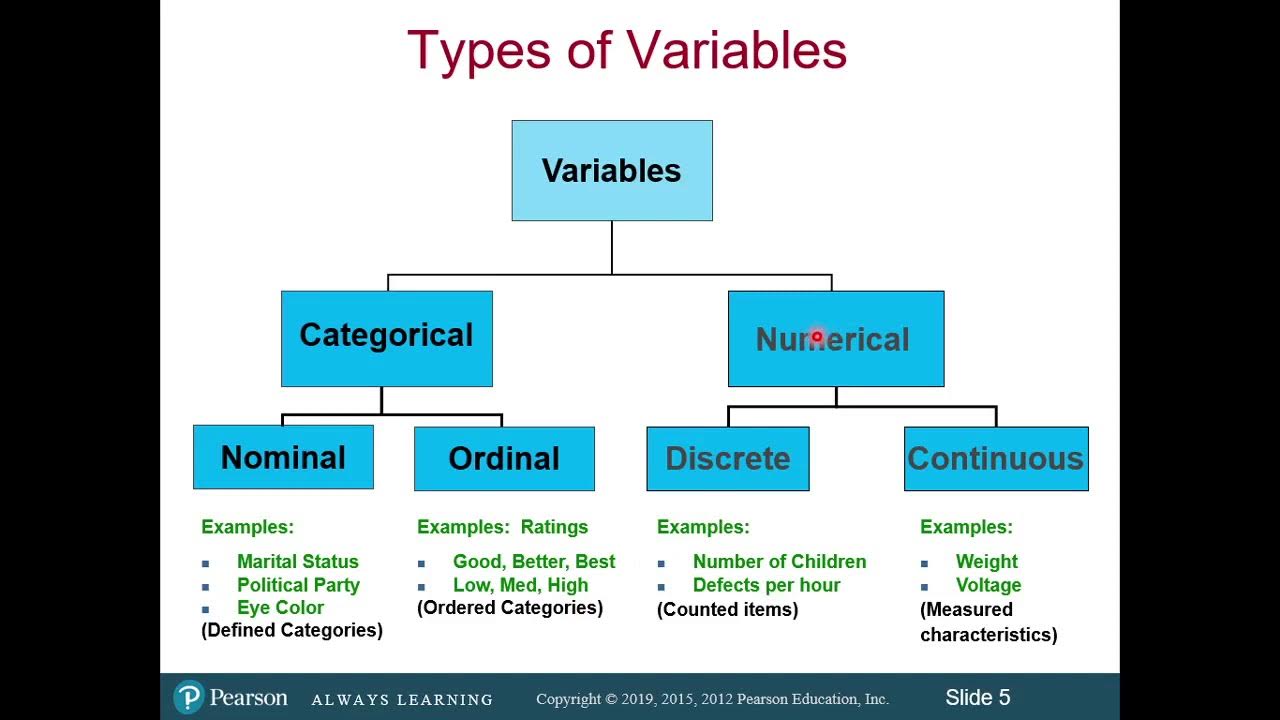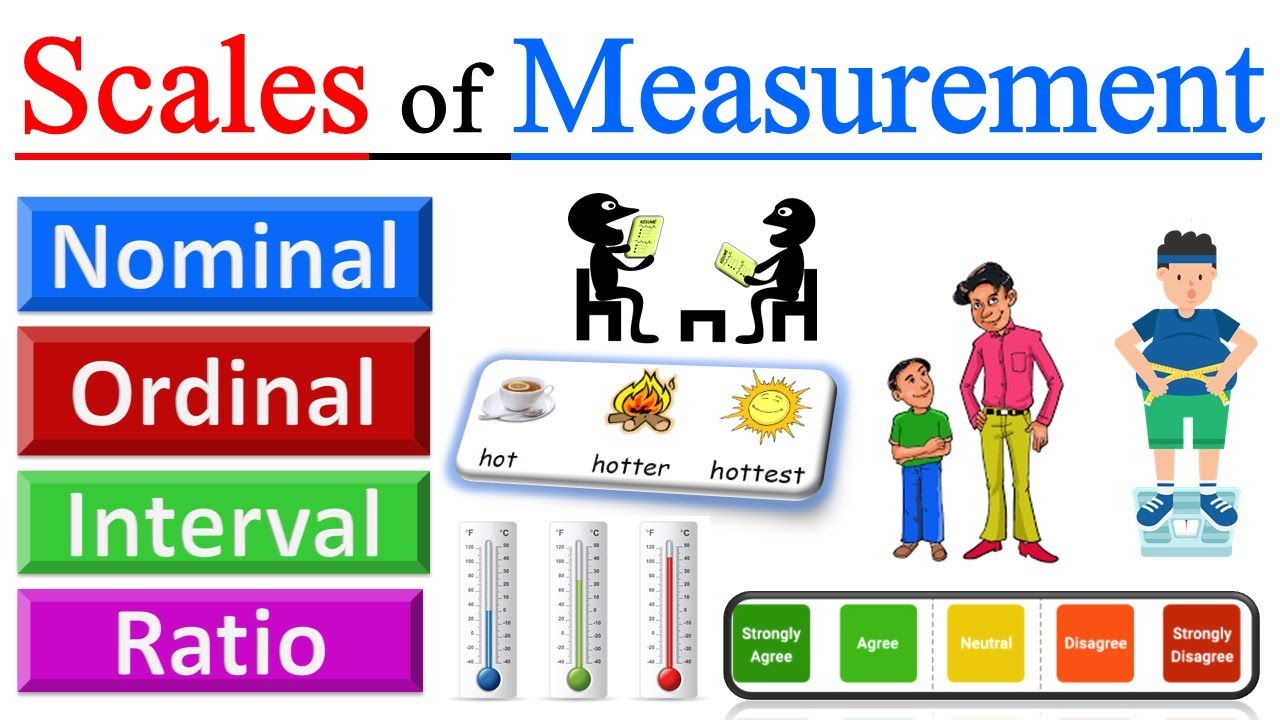Introduction to Statistics: Levels of Measurement
TLDRThis video script delves into the fundamentals of statistical analysis, emphasizing the importance of accurate measurement of dependent variables. It outlines four basic scales of measurement: nominal, ordinal, interval, and ratio, each with distinct properties. The script clarifies that the type of scale used dictates the kind of statistical analysis possible, and highlights the pitfalls of misapplying scales, such as averaging nominal data. It also touches on the complexities of psychological measurements, challenging the straightforward application of these scales to subjective experiences.
Takeaways
- 📏 Different types of variables require different measurement methods, such as stopwatches for time and rating scales for attitudes.
- 🏷️ Nominal scales are used for categorizing without implying any order, like favorite color or religion.
- 🔄 Ordinal scales allow for ordering categories, such as consumer satisfaction levels or military ranks, but don't capture equal intervals between categories.
- ⚖️ Interval scales are numerical and have equal intervals, like the Fahrenheit temperature scale, but lack a true zero point.
- 💰 Ratio scales are the most informative, combining properties of nominal, ordinal, and interval scales, with a true zero point, like the amount of money.
- 🔢 Psychological variables often use rating scales, which are typically ordinal, not interval, due to the lack of assurance that differences are equal across the scale.
- 🧠 In memory experiments, the number of items correctly recalled can be considered a ratio scale, assuming a true zero point and equal difference in recall.
- 🤔 The level of measurement affects the type of statistical analysis that can be applied, with nominal scales not suitable for mean calculations.
- 📊 The choice of scale is crucial for the validity of statistical conclusions, as demonstrated by the inappropriateness of averaging nominal scale data.
- 🎨 The script uses the example of favorite color to illustrate the absurdity of averaging nominal data, which doesn't reflect an 'average' category.
- 🔮 The debate over the appropriateness of calculating means for ordinal scales is ongoing, with statisticians having differing opinions on its validity.
Q & A
What are the four basic scales of measurement mentioned in the script?
-The four basic scales of measurement are nominal, ordinal, interval, and ratio.
How are nominal scales different from ordinal scales?
-Nominal scales simply categorize responses without implying any order, whereas ordinal scales categorize and also indicate a meaningful order among the responses.
What is an example of a nominal scale measurement?
-Examples of nominal scale measurements include gender, handedness, favorite color, and religion.
How does an ordinal scale differ from a nominal scale in terms of the information it provides?
-An ordinal scale allows for comparisons in the degree to which two subjects possess the dependent variable, which is not possible with nominal scales.
What is the main characteristic of an interval scale?
-An interval scale is a numerical scale where intervals have the same interpretation throughout, meaning the difference between any two levels is consistent.
Why is the Fahrenheit scale not considered a perfect interval scale?
-The Fahrenheit scale is not perfect because it does not have a true zero point, which means it does not represent the complete absence of temperature or molecular kinetic energy.
What is the key feature of a ratio scale that distinguishes it from an interval scale?
-A ratio scale has a true zero point, indicating the absence of the quantity being measured, which allows for meaningful computation of ratios.
Why might it be inappropriate to consider psychological measurement scales as interval or ratio?
-It might be inappropriate because psychological measurements often do not ensure that a given difference represents the same thing across the scale, making it difficult to apply the properties of interval or ratio scales.
What is an example of a ratio scale measurement mentioned in the script?
-An example of a ratio scale measurement is the amount of money one has, such as 25 cents or 55 cents.
How does the script illustrate the potential issue with computing the mean of nominal scale data?
-The script uses the example of children's favorite colors, where computing the mean of numerical codes assigned to the colors does not make sense, as it would incorrectly imply an 'average' favorite color.
Outlines
📏 Types of Measurement Scales in Statistics
This paragraph introduces the concept of measurement in statistical analysis and the importance of selecting the appropriate scale based on the type of variable. It explains four fundamental scales: nominal, ordinal, interval, and ratio. Nominal scales categorize without implying order, ordinal scales order categories meaningfully, interval scales have equal intervals but no true zero, and ratio scales have both equal intervals and a true zero point. The paragraph provides examples such as favorite color, political attitude, and temperature to illustrate these scales and emphasizes the limitations and properties of each.
🔢 Interval Scales and Their Limitations
The second paragraph delves deeper into interval scales, highlighting their equal intervals but pointing out the lack of a true zero point, which prevents the calculation of meaningful ratios. It uses the Fahrenheit temperature scale as an example to illustrate this limitation. The paragraph also contrasts interval scales with ratio scales, which include the properties of interval scales and additionally have a true zero point, allowing for ratio comparisons. Examples such as money and psychological variables measured on rating scales are given to show the practical application of these scales in research.
🤔 The Complexity of Psychological Measurement
The third paragraph discusses the complexities involved in measuring psychological variables, particularly the challenges in determining whether to use ordinal or interval scales for variables like pain levels or the number of items recalled in memory experiments. It points out that psychological measurements often do not fit neatly into traditional scale categories due to the subjective nature of the data and the difficulty in ensuring that differences between scale values represent equal intervals of the underlying construct. The paragraph also touches on the implications of scale type for the statistical analysis, suggesting that the choice of scale can affect the validity of statistical conclusions.
Mindmap
Keywords
💡Statistical Analysis
💡Dependent Variables
💡Measurement Scales
💡Nominal Scale
💡Ordinal Scale
💡Interval Scale
💡Ratio Scale
💡Psychological Variables
💡Memory Experiments
💡Level of Measurement
💡Meaningful Statistics
Highlights
The importance of measuring dependent variables accurately for statistical analysis.
Different measurement methods for different types of variables: nominal, ordinal, interval, and ratio scales.
Nominal scale is used for categorizing without implying any order, such as gender or favorite color.
Ordinal scale allows for ordered categorization, like consumer satisfaction levels.
Interval scale introduces equal intervals between scale values, such as the Fahrenheit temperature scale.
Ratio scale is the most informative, with a true zero point, like measuring money.
The difference between ordinal and interval scales in terms of equal intervals and true zero points.
Psychological variables often use rating scales, which are typically ordinal, not interval.
Memory experiments often use the number of items correctly recalled, which can be considered a ratio scale.
The complexity of measuring psychological variables and the debate over interval vs. ratio scales.
The inappropriateness of averaging nominal scale data, such as favorite color.
The debate among statisticians about the meaningfulness of computing the mean of ordinal scales.
Transcripts
Browse More Related Video

Scales of Measurement

Scales of Measurement - Nominal, Ordinal, Interval, Ratio (Part 2) - Introductory Statistics

Classification of Variables and Types of Measurement Scales

Nominal, ordinal, interval and ratio data: How to Remember the differences

Scales of Measurement: Nominal, Ordinal, Interval and Ratio Scale

Scales of Measurement in Statistics - Nominal, Ordinal, Interval, Ratio | Level of Measurement
5.0 / 5 (0 votes)
Thanks for rating: